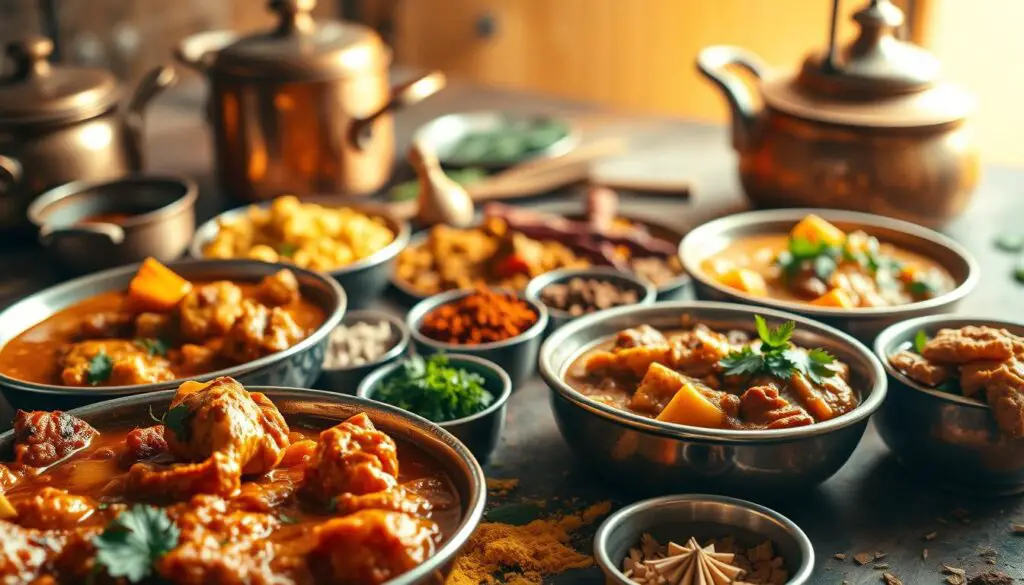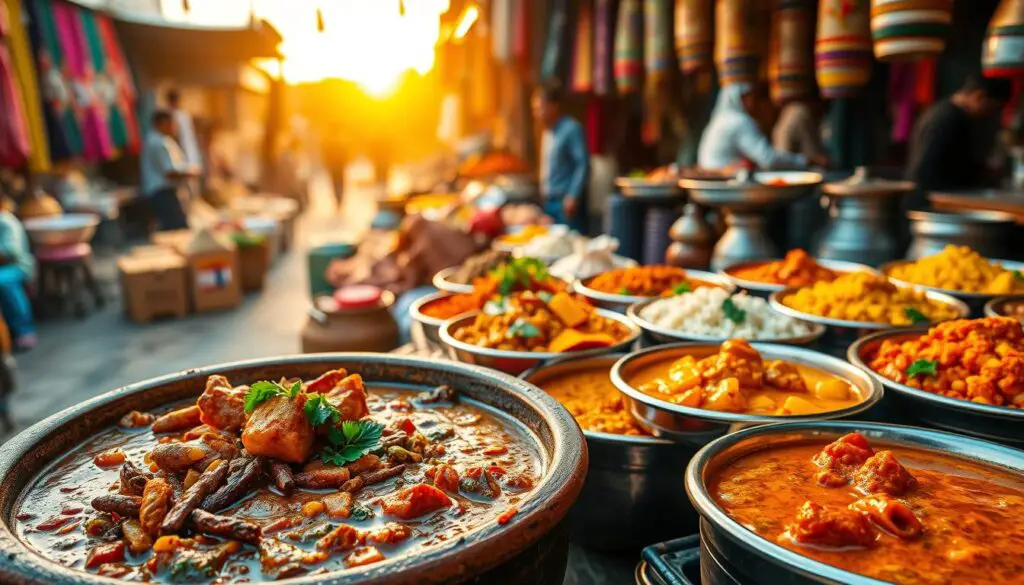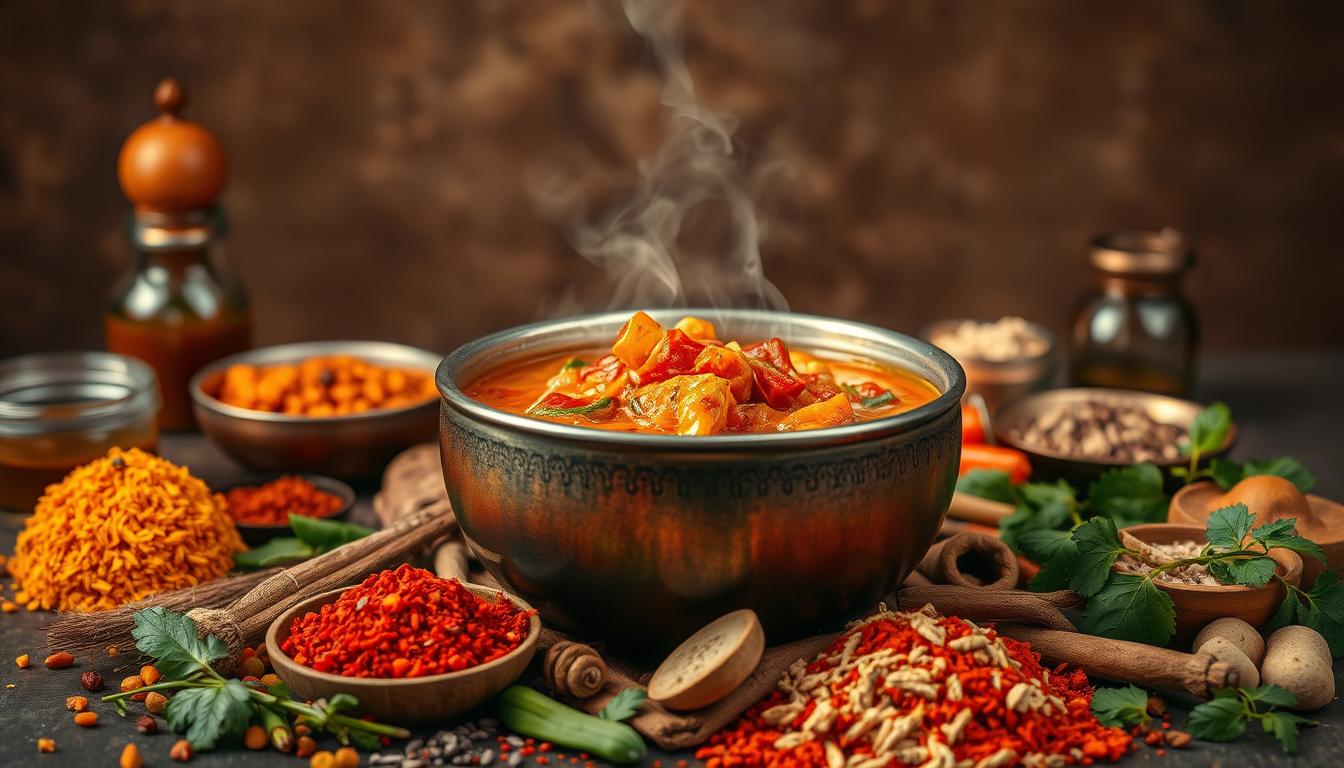We’ll look at how spices and fresh ingredients come together. These elements make the dishes not only tasty but also share stories of India’s food heritage.
I visit a Lahore Indian restaurant in London and a chilies and thyme Indian restaurant in Chichester to get a taste of some real authentic Punjab Indian cuisine. I try a Seafood Moilee and a gosht rogan Josh with papadums and pashwari naan bread. We’ll look at how spices and fresh ingredients come together. These elements make the dishes not only tasty but also share stories of India’s food heritage.
Key Takeaways
- Understanding authentic Indian curry involves recognizing its regional diversity.
- Key spices and fresh ingredients are essential in crafting authentic curries.
- Regional Indian curry variations showcase the cultural richness of the country.
- Exploring these dishes provides insight into traditional cooking techniques.
- Authentic Indian curry is more than just a dish; it is an experience of flavors.
Introduction to Authentic Indian Curry
Authentic Indian curry is a key part of Indian cuisine. It shows the rich culture and varied flavors of India. The spices used in these dishes tell stories of local traditions and ingredients.
These flavors take you on a journey across India. From the north’s aromatic spices to the south’s vibrant seasonings, each taste is unique.
Looking into traditional Indian curry recipes, you learn about the art of cooking. You also see how important food is in Indian culture. Meals are often shared with family and friends, making them special moments.
This cultural aspect makes each recipe more than just food. It’s a way for people to come together and enjoy the authentic flavors of India.
What is Authentic Indian Curry? Real Indian Curry is Diverse, Regionally Unique
What is authentic Indian curry? It’s not just one recipe or flavor. It’s a wide range of regional flavors, each unique. These differences show the rich variety of Indian cuisine.
In Northern India, curries are creamy and rich. They often use tomatoes and dairy. Butter chicken is a great example, with its smooth texture and spices.
Southern Indian curries are bold and use a lot of coconut milk. This gives them a special taste that’s different from the rest.
In the East, curries are sweeter, with mustard oil and poppy seeds. The West is spicy, with dishes that use local spices and ingredients. Each region’s curry shows its own culture and tastes.
To really understand authentic Indian curry, you need to explore these regional differences. The spices and cooking methods vary by area. This makes Indian curry a dynamic reflection of India’s culture and traditions.
Key Ingredients: The Heart of Indian Curry
Indian curry is all about its rich mix of ingredients. These elements are what make each dish flavorful and aromatic. To truly experience Indian cuisine, you need to explore authentic curry spices and fresh ingredients. They take traditional recipes to a whole new level.
Understanding Authentic Curry Spices
Authentic curry spices are key to Indian curries. Each spice has its own unique taste. They add warmth, depth, and complexity to the dish. Here are some must-have spices:
- Cumin: Known for its earthy flavor, cumin adds a smoky touch to curries.
- Coriander: This spice offers a citrusy undertone, perfect for brightening up rich dishes.
- Turmeric: Often referred to as “Indian saffron,” turmeric imparts a vibrant yellow color and a mild, peppery taste.
- Garam Masala: A blend of various spices, garam masala serves as a finishing touch, warming and rounding out flavors.
The Role of Fresh Ingredients in Traditional Recipes
Fresh ingredients are just as important as spices in traditional Indian curry recipes. They add vibrant flavors, making each bite authentic. Key components include:
- Vegetables: Seasonal and local produce not only enhance texture but bring freshness and color to the curry.
- Meats: Fresh cuts of chicken, lamb, or seafood marinated in spices intensify the dish’s flavor profile.
- Herbs: Fresh cilantro or mint leaves provide a burst of herbal notes, balancing the richness of the curry.
Regional Indian Curry Variations: A Culinary Journey
Exploring regional Indian curry variations shows the amazing diversity of Indian cuisine. Each area has its own special flavors and cooking ways. This leads to many types of Indian curries that excite our taste buds and warm our hearts.
From creamy Northern curries to spicy Southern ones, each dish is unique and fascinating. These differences make Indian cuisine both captivating and educational.
Northern Indian Curries: Rich and Creamy
Northern Indian curries are famous for their creamy texture. They often include butter, cream, and yogurt. Dishes like butter chicken and paneer tikka masala are perfect examples.
These curries are made by slow simmering. This method lets the flavors mix well, creating a rich and comforting taste.
Southern Indian Curries: Spicy and Flavorful
Southern Indian curries, on the other hand, are known for their bold flavors. They use a lot of coconut and ingredients like curry leaves and mustard seeds. Sambar and fish curry are great examples.
These recipes are cooked lightly, focusing on fresh veggies and seafood. This highlights the bright tastes of the South.
Popular Indian Curry Dishes to Try
Exploring popular Indian curry dishes reveals two standout options. They showcase the unique flavors and cooking techniques of Indian cuisine. These dishes offer a delicious look into the regional diversity of Indian food, making them essential for any food enthusiast.
Butter Chicken: A Star of North Indian Cuisine
Butter chicken, or Murgh Makhani, comes from Delhi and is loved worldwide. It features tender chicken cooked in a creamy tomato sauce with spices. The addition of butter and cream makes it rich and smooth, balancing the spices.
The chicken is marinated in yogurt and spices, keeping it juicy. Serving it with naan or basmati rice makes the experience even better. It’s a favorite among popular Indian curry dishes.
Rogan Josh: A Testament of Kashmir Flavors
Rogan Josh is a highlight of Kashmir cuisine. It’s made with lamb or goat in a flavorful curry of yogurt, garlic, and spices. The use of Kashmiri red chili gives it a unique color and taste without being too hot.
The slow-cooking process blends the flavors, making the meat tender. Enjoying it with steamed rice highlights the comfort and tradition of Indian curry dishes.
Traditional Indian Curry Recipes for Home Cooks
Exploring Indian cuisine is exciting. Traditional Indian curry recipes are full of flavors and techniques. They are easy for home cooks to follow, making delicious homemade curries.
How to Make a Classic Chicken Curry
This Classic Chicken Curry is loved by many. It has aromatic spices and tender chicken. Here’s how to make it:
- Ingredients: 1 kg chicken, 2 onions (finely chopped), 2 tomatoes (pureed), 1 tablespoon ginger-garlic paste, spices (cumin, coriander, turmeric, garam masala), and cooking oil.
- Preparation: Heat oil in a pan and saute onions until golden.
- Add ginger-garlic paste and cook until the smell goes away.
- Stir in tomatoes and let it simmer.
- Add spices and cook for a few minutes to mix flavors.
- Then, add chicken and cook until tender. Serve with rice or naan.
Vegetarian Options: Paneer Tikka Marsala
Paneer Tikka Marsala is a great vegetarian option. It has rich flavors and a creamy sauce, perfect for a meal.
- Ingredients: 500 grams paneer, 2 bell peppers, 1 onion (cubed), 1 cup yogurt, spices (red chili powder, cumin, coriander), and cooking oil.
- Mix yogurt with spices and marinate paneer for 30 minutes.
- Skewer marinated paneer and vegetables, then grill until charred.
- Make a sauce with onions, tomatoes, and spices in a pan.
- Add grilled paneer and vegetables to the sauce and simmer.
- Serve with rice, naan, or roti for a great meal.

Homemade Indian Curry: Tips and Techniques
Making a homemade Indian curry brings authentic flavors to your kitchen. Learning key techniques can make your dishes more vibrant and satisfying. Focus on slow cooking and making your own spice blends.
Understanding the Importance of Slow Cooking
Slow cooking melds flavors, making your curry taste better. It tenderizes meat and softens veggies, creating a delicious dish. A curry tastes even better the next day, as the spices infuse deeper into the ingredients.
Try to cook your curry for a long time. This lets the ingredients reach their best flavor. You’ll enjoy a symphony of authentic Indian flavors that will please your taste buds.
Creating Your Spice Blends
The key to a great curry is its spices. Mixing your blends lets you customize the flavor. Here are some essential spices:
- Cumin seeds
- Coriander powder
- Turmeric
- Garam masala
- Cardamom pods
Using whole spices keeps them fresh and potent. Toast them before grinding to release their oils. This method boosts flavor and lets you experiment with different spice combinations.
| Spice | Flavor Profile |
|---|---|
| Cumin Seeds | Earthy and warm |
| Coriander Powder | Citrusy and sweet |
| Turmeric | Warm and slightly bitter |
| Garam Masala | Complex and aromatic |
| Cardamom Pods | Sweet and spicy |
The Difference Between Authentic and International Indian Curry
Curry has a big difference between authentic and international versions. International curries are often easier and more familiar. But authentic curry dives deep into the rich flavors of Indian cuisine.
International dishes might use creamy sauces and simple recipes. This can hide the true flavors of authentic curries.
Why Authentic Curry is More Than Just Creamy Sauces
Authentic Indian curry is more than just a sauce. It’s about understanding ingredients, cooking, and culture. The way spices are layered adds depth and complexity.
This makes the experience more than just eating. It’s a journey of flavors.
- Ingredient Freshness: Authentic curry uses fresh herbs and spices. This creates bright, real flavors that canned or powdered can’t match.
- Cooking Techniques: Slow cooking lets ingredients blend together. This creates a rich taste that international versions often miss.
- Regional Influences: Indian curry changes by region. Each area has its own spices and styles, showing local culture and climate.

To really get it, you need to try authentic Indian curry. It’s not just about what you eat. It’s about how you experience it, with all your senses.
Embracing Authentic Indian Flavors in Your Cooking
Creating authentic Indian dishes at home can make mealtime exciting. Simple steps that use authentic techniques are key. They help you make meals full of real Indian flavors. Here are some tips to improve your cooking.
How to Incorporate Authentic Techniques at Home
For those eager to explore Indian cuisine, learning key methods is important. Here are a few tips:
- Use whole spices: Whole spices like cumin seeds, cardamom pods, and mustard seeds add a lot of flavor. They release their aroma when heated in oil, making your dishes smell amazing.
- Engage in slow cooking: Letting dishes simmer makes ingredients tender and flavors blend well. It shows the value of patience in cooking.
- Balance of flavors: Indian food is all about mixing sweet, sour, salty, and spicy. Getting this right makes your dishes lively and true to Indian traditions.
Using these techniques will elevate your cooking. Trying different regional styles and flavors can lead to tasty meals. These meals will honor the true essence of Indian cuisine.
Conclusion
The world of authentic Indian curry is full of flavors and traditions. Each region has its own special take. This journey through different Indian curries shows a wide range of tastes.
Whether it’s the creamy textures of the North or the spicy flavors of the South, there’s something for everyone. Every food lover can find a new authentic Indian curry to try.
When you try these unique flavors, remember the importance of fresh spices and traditional cooking. These ingredients honor Indian cuisine’s heritage and make cooking at home better. By trying your own versions of these recipes, you can bring the heart and soul of Indian curry into your kitchen.
So, dive into the world of regional Indian curry variations. Each dish has its own story, heritage, and invites you to connect with a culture that loves food. Let your creativity shine and follow the spices on a fun culinary journey!
FAQ
What is authentic Indian curry?
What are some popular types of Indian curry?
Can you suggest some traditional Indian curry recipes?
How do regional variations affect Indian curry?
What are authentic curry spices?
How can I make homemade Indian curry?
Why are authentic Indian dishes different from international versions?
What tips do you have for embracing authentic Indian flavors at home?
Latest Posts
- Chichester Canal Boat Ride: Discover the Tranquil Waterway

- Why Paddleboarding is Becoming a Favorite Water Activity

- Over 60 and Can’t Get Employed? Solutions for Older Job Seekers

- 5 Must-Try popular Brazilian Dishes You’ll Love


